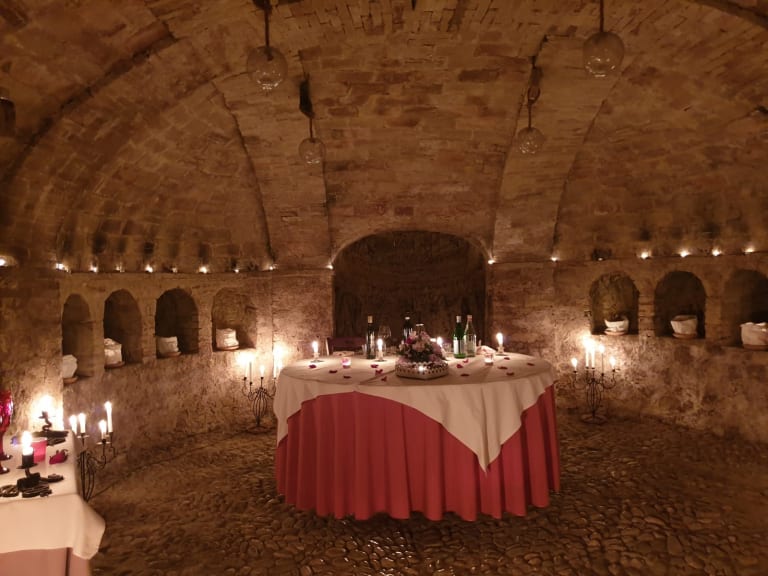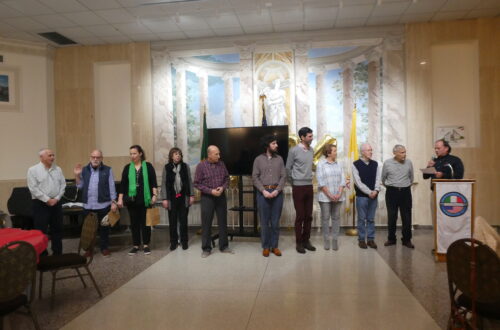
Canzano

By Nancy DeSanti

Credit: eurcamping.it
Province of Teramo, Region of Abruzzo
The beautiful small town of Canzano in the province of Teramo has approximately 1,861 inhabitants, known as Canzanesi. It is renowned as one of the centers of traditional Abruzzese cuisine.
Canzano is located on a group of hills in the northern Vomano valley in a strategic position which explains the importance of this nowadays small center.
Historians have determined that the territory was inhabited in prehistoric times, and neolithic arrows have been found in the vicinity. During the Iron Age, it was settled by the ancient Italic tribe of Praetutii and later by the Romans.
The town of Canzano is located on a hill from which one can admire a striking view of the valley below and the chain of the Gran Sasso mountains. The built-up area is made up of noble palaces, 16th century houses, valuable churches, and still very visible remains of the ancient city walls, from which a well-preserved tower stands out. Very striking is a dense network of caves that are true and proper “cold rooms” once used to collect rainwater and to conserve foodstuffs.
On the Colle Castellano, there stands the splendid baroque church of the Madonna dell’Alno where, according to legend, the Virgin Mary appeared three times to a peasant. On the place of the first apparition, there stands the small church of the “Forgiveness.” In the Romanesque church of San Salvatore, beautiful frescoes from the 14th century are preserved.
Canzano is famous for its handmade production of lace and embroidery– traditions handed down by the women of the town with passion and patience.
The town is probably most famous for a traditional recipe passed from generation to generation–the famous “Canzanese turkey” (tacchino alla canzanese). This delicious jelly dish, served with a side of pickles, was almost a casual discovery. The local people realized that turkey broth prepared in the morning became gelatinous towards evening, thus incredibly enhancing the flavor of the meat. The recipe strictly requires the female turkey because its tender meat is more suitable for oven cooking.
Consolidated over time, the ancient recipe is the undisputed favorite of the restaurant La Tacchinella. With now four generations in command, family owners have been running it since 1970.
But it is eight meters (26.25 feet) below the restaurant where an ancient wonder dating back to about the year 1100 A.D. can be found — the so-called neviera (ice house). The ice house is an old structure for natural refrigeration, by which meat was once stored using snow. After pressing the snow into straw, which insulated the snow, the result of a combination of snow and straw was then placed inside niches to lower the temperature and to obtain a true and proper cold room. While the air continued to circulate, the temperature was able to go down to zero degrees in winter. When spring arrived, the melted snow was then filtered and held aside as clean water for domestic use, without any waste.
This thousand-year-old invention was brought to Canzano by the Saracens, as portrayed in the emblem of the town, and it represents a living testimony of ancient technology. Today, besides being a wine cellar, the ice house is an enchanted place where visitors can enjoy an exclusive candlelit dinner, eight meters under the ground and a thousand years back in time.
What to See
- Remains of the medieval walls with a majestic circular tower.
- Church of Madonna dell’Alno, from the 16th century, with Renaissance and Baroque paintings.
- Church of San Salvatore, outside the walls, with a stone portal and 14th-century frescos, including one depicting St. Louis of France, the Crusaders’ patron.
- Sancti Petri ad Palustrium, a small 12th-century church.
Important Dates
- February 3 – Feast of San Biagio, the patron saint of the town.
- May 18-20 – Celebration of Madonna dell’Alno.
- July 26 – Celebration of Sant’Anna, patron saint of women giving birth.
- First week in August – Exhibition of ancient and contemporary lacework, and Sagra of the Canzanese Tacchino.
- August – Exhibition of antique agricultural machines.
- August – Rendezvous of classical and antique motorcycles.
Italiano

Tradotto da Ennio Di Tullio
Provincia di Teramo, Regione Abruzzo
La bellissima cittadina di Canzano nella provincia di Teramo ha circa 1.861 abitanti, detti Canzanesi. È rinomato come uno dei centri della cucina tradizionale abruzzese.
Canzano è situato su un gruppo di colline nel nord valle del Vomano in una posizione strategica che spiega l’importanza di questo piccolo centro oggi.
Gli storici hanno stabilito che il territorio era abitato in epoca preistorica e nelle vicinanze sono state rinvenute frecce neolitiche. Durante l’età del ferro, fu colonizzato dall’antica tribù italica dei Praetutii e successivamente dai Romani.
Il comune di Canzano è situato su un colle dal quale si può ammirare un suggestivo panorama sulla valle sottostante e sulla catena del Gran Sasso montagne. L’abitato è costituito da palazzi nobiliari, case cinquecentesche, chiese di pregio, e resti ancora ben visibili dell’antica cinta muraria, da cui svetta una torre ben conservata. Molto suggestiva è la fitta rete di grotte che sono vere e proprie “celle frigorifere” un tempo utilizzate per raccogliere l’acqua piovana e conservare le derrate alimentari.
Sul Colle Castellano ci sorge la splendida chiesa barocca della Madonna dell’Alno dove, secondo la leggenda, la Vergine Maria apparve tre volte ad un contadino. Sul luogo della prima apparizione, ci sorge la piccola chiesa del “Perdono”. Nella chiesa romanica di San Salvatore, ci sono conservati bellissimi affreschi del XIV secolo.
Canzano è famosa per la produzione artigianale di pizzi e ricami, tradizioni tramandate dalle donne del paese con passione e pazienza.
La comune è probabilmente famosa soprattutto per una ricetta tradizionale tramandata da generazione a generazione: il famoso “tacchino alla canzanese” (canzanese turkey). Questa deliziosa gelatina, servita con un contorno di sottaceti, è stata quasi una scoperta casuale. La gente del posto si accorse che il brodo di tacchino preparato al mattino divenava gelatinoso verso la sera, così esaltava incredibilmente il sapore della carne. La ricetta richiede rigorosamente la femmina di tacchino perché la sua carne tenera è più adatta alla cottura al forno. Consolidata nel tempo, l’antica ricetta è la preferita indiscussa del ristorante La Tacchinella. Con ormai quattro generazioni al comando, la famiglia proprietaria lo gestisce dal 1970.
Ma è otto metri (26.25 piedi) sotto il ristorante che si nasconde un’antica meraviglia risalente al 1100 D.C.: la cosiddetta neviera (ghiacciaia). La ghiacciaia è una antica struttura per refrigerazione naturale, dove un tempo la carne veniva conservata utilizzando la neve. Dopo averlo pressato la neve nella paglia, che isolava la neve, la risulta di una combinazione di neve e paglia veniva poi riposto all’interno di nicchie per abbassare la temperatura e ottenere una vera e propria cella frigorifera. Mentre l’aria continuava a circolare, la temperatura poteva scendere fino a zero gradi in inverno. Quando la primavera arrivava, la neve sciolta veniva poi filtrata e tenuta da parte como aqua polita per l’uso domestico, senza alcuno spreco.
Questa invenzione millenaria fu portata a Canzano dai Saraceni, come raffigurato nello stemma del comune, e rappresenta una testimonianza vivente di antica tecnologia. Oggi, oltre ad essere una cantina, la ghiacciaia è un luogo incantato dove i visitatori possono godersi un’esclusiva cena a lume di candela, otto metri sotto la terra e mille anni indietro nel tempo.
Attrazioni del luogo:
- Resti delle mura medievali con una maestosa torre circolare.
- Chiesa della Madonna dell’Alno, del XVI secolo, con dipinti rinascimentali e barocchi.
- Chiesa di San Salvatore, fuori le mura, con portale in pietra e affresci del XIV secolo, tra cui uno raffigurante S. Luigi di Francia, mecenate dei crociati.
- Sancti Petri ad Palustrium, piccola chiesa del XII secolo.
Date da ricordare:
- 3 febbraio – Festa di San Biagio, il patrono del comune.
- 18-20 maggio – Festa della Madonna dell’Alno.
- 26 luglio – Festa di Sant’Anna, patrona delle partorienti.
- Prima settimana di agosto – Mostra di merletti antichi e contemporanei e Sagra della Tacchino Canzanese.
- Agosto – Mostra mercato di macchine agricole antice.
- Agosto – Appuntamento di motociclette classiche e antice.
July 2024





